The oldest text about marine works we know of is Philon of Byzantium’s text that is unfortunately lost (ca. 250 BC). Vitruvius’ “de Architectura” dated around 20 BC, is the only ancient text left about marine works. In his time, ‘Puteolanus pulvis’ (often translated by ‘pozzolana’) is already in use for hardening concrete under water, replacing crushed ceramics used by the Greeks long before that. The resulting mass of ‘hydraulic concrete‘ is “neither particularly hard nor strong” but provides an “extraordinary longevity in sea-water” (from Oleson et al., 2014)[1].
Vitruvius described three methods for building port structures, but unfortunately, none of his sketches survived and this makes interpretation of his three methods quite hard[2] .
The first method of Vitruvius consists of dumping pozzolana mortar with rubble inside an enclosure made of poles (“stipites”) that are driven into the subsoil in order that these materials replace water by falling into the enclosure. This method is made possible by the use of hydraulic concrete (that hardens under water) which is made with pozzolana (provided materials are lowered with help of baskets and not just dumped into the water from the surface). This method supposes that piles can be driven into the subsoil and that they will resist the pressure of mortar before hardening (in the second method, Vitruvius mentions two months of hardening, while modern concrete would take less than one month). If needed, tie rods can be inserted between opposite faces of the enclosure. Such tie rods were made of wooden beams (“catenae”), supported by poles (“destinae”), which have disappeared with time, leaving transversal cavities inside the structure.
In any case, the enclosure height could not be much more than a few meters, but this was an acceptable water depth for ancient ships.
Note also that the pressure of hydraulic concrete is exerted from inside to outside the caisson-wall and that stipites are therefore placed outside the wall, thus leaving no cavities on the resulting concrete wall (see Brandon’s sketch below).
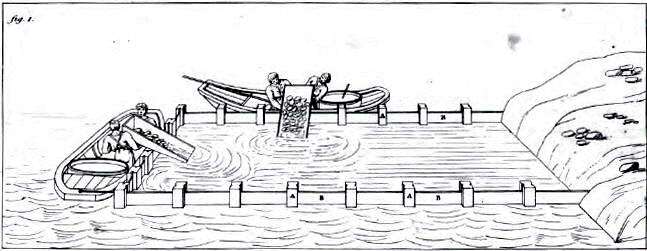
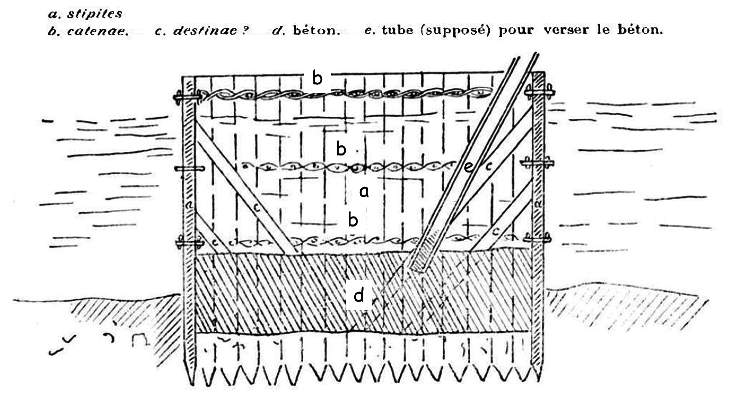
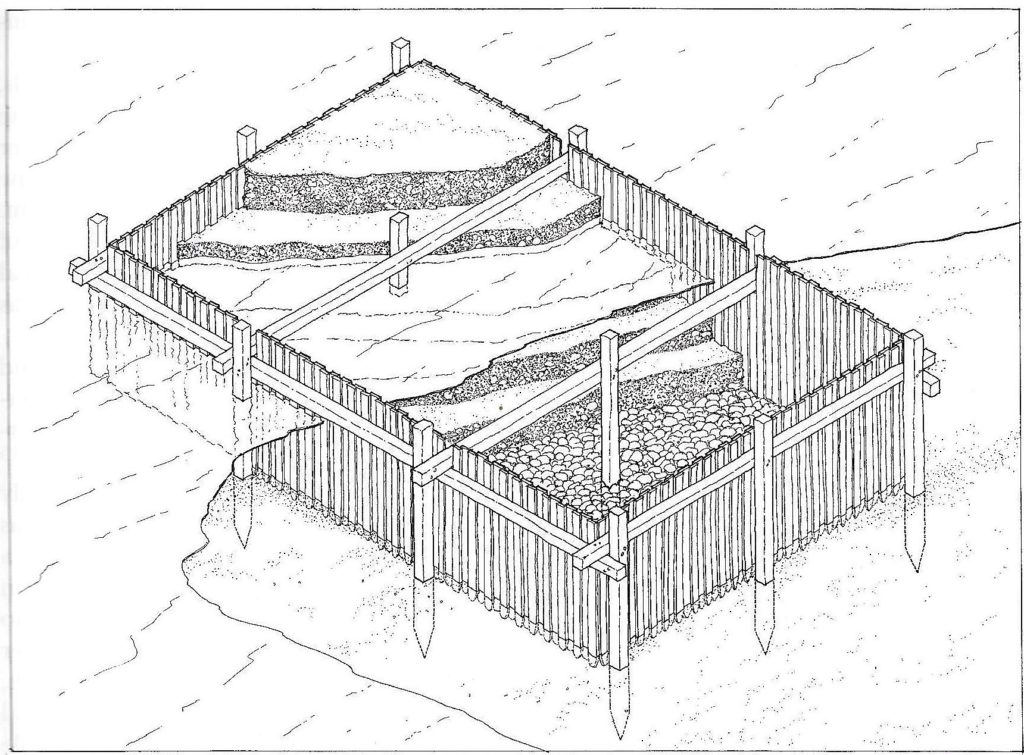
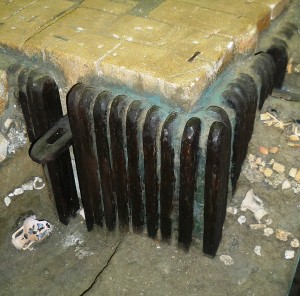
On this model of the Môle de la Marseillaise (at La Nautique near Narbonne), the piles are juxtaposed and tied by horizontal tie rods with a system of tenon and mortise that can still be seen.
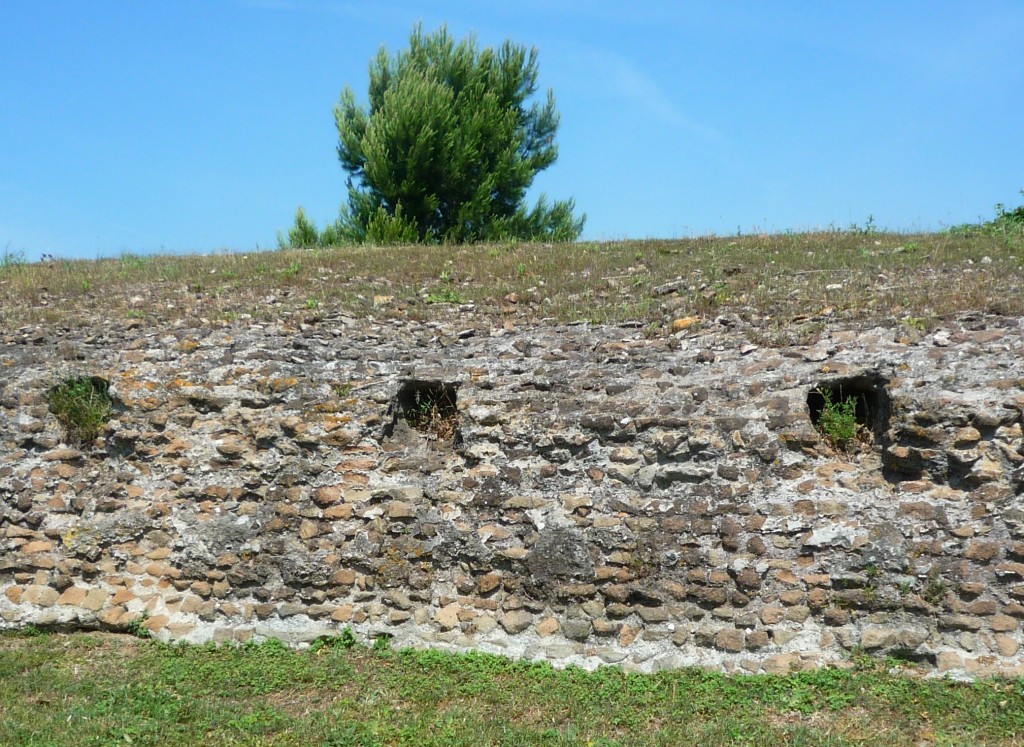
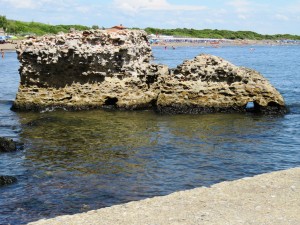
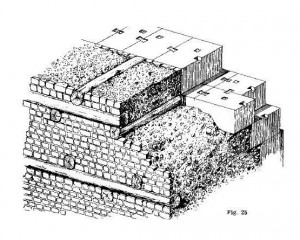
Bartocini describes a similar structure on the South breakwater of Leptis Magna.
According to C. Brandon (1996 & 2010) this method was widely used: Anzio, Astura, Cosa, Circeii, Egnazia, Sapri, Santa Severa, San Marco de Castellabate, Portus Claudius, Misenum and Baiae (Italy), Marseille (France), Side (Turkey), Caesarea (Israel), Thapsus (Tunisia) and probably the eastern jetty of Leptis Magna where large masses of concrete are still submerged.
It is sometimes suggested that some of the pilae remains found today might be the remains of arched breakwaters.
A similar method with an enclosure made of ashlar blocks instead of wooden piles was used, according to Brandon, at San Cataldo (Italy), and Pompeiopolis and Kyme (Turkey).
An alternative to this first method consists of prefabricating a rigid wooden enclosure, with or without a bottom, which is then floated to the desired location before being filled with hydraulic concrete or stones. Such a structure is now called a “floating caisson” (modern caissons are made of concrete and have a bottom in order to float). This alternative method is well suited for hard (rocky) seabeds where piles cannot be driven. This alternative seems to have been used for a stone wall at the Port des Laurons (Martigues, France)[3] and possibly for breakwaters at Hereum (Fenerbahçe, near Istanbul)[4] and Lechaion (Corinth, Greece)[5] during Late Antiquity. It reached a technological summit at Caesarea Maritima (Israel).
In the latter case, Flavius’ description mentions blocks of 50 x 18 (or 10?) x 9 feet (15 x 5.5 x 2.75 m), that is nearly 600 tons (archaeology has even revealed blocks of 14 x 7 x 4 m, or 1000 tons). Archaeological excavations showed imprints inside and under the concrete mound, proving that the structure consisted of wooden caissons used as lost formworks for concrete to be poured in situ. Such caissons with a bottom could be built on a nearby beach and be floated to their final position. This concept is similar to sinking an old ship to build a man-made island like the one of Portus Claudius (Pliny, NH, 36, 14, 9). A series of sunken ships was found at Heracleion-Thonis (Egypt) where shipwrecks may have been used for a jetty in the 4th-5th century BC[7]. In Narbonne, an old boat was used to repair a breach in the eastern training wall of the port[8].
A 40-cm thick layer of rounded cobbles (up to 35 cm diameter) was found underneath a large concrete block of the Caesarea western breakwater. This foundation method allows a strong flow within the foundation layer, e.g., with a wave having its crest outside and its trough inside the port. Such an alternate flow will erode sand underneath and thus undermine the whole structure[6].
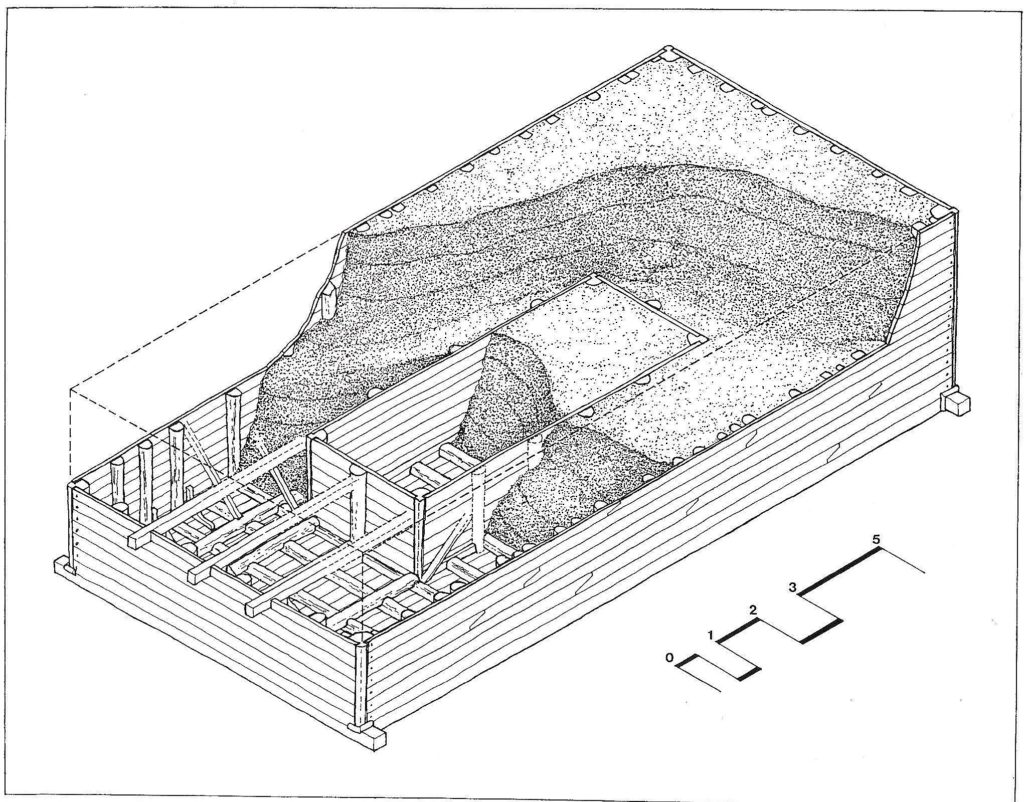
A particular refinement shown in the sketch above, is the central box of the floating caisson which is surrounded by hydraulic concrete and therefore absolutely dry, enabling the use of cheaper non-hydraulic concrete inside that box.
A variant of this method which was used only on the northern breakwater at Caesarea Maritima, consisted of a large double-walled caisson without floor constructed on shore and towed into position. Once on location, the space between the two walls was filled with mortar until the whole formwork sank to the bottom. Only then was it filled with hydraulic concrete. The size of the block recovered is 15 x 11.5 x 2.4 m, again, around 1000 tons.
Vitruvius may not have been informed about the floating caissons used at Caesarea as they were built between 21 and 10 BC., i.e. just after he wrote his book around 20 BC
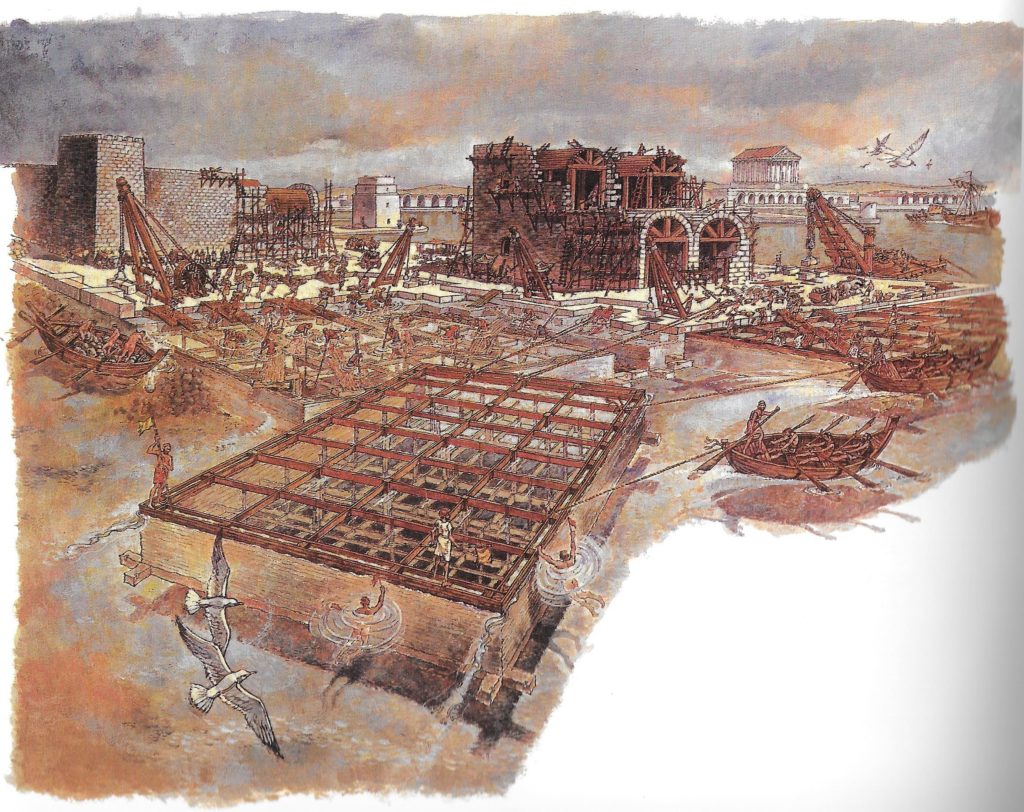
Vitruvius’ third method is close to the first method as it also requires an enclosure, albeit a watertight one (we now call this a “cofferdam”) allowing water to be pumped out in order to enable work in the dry. Hydraulic concrete and pozzolana are thus not required in this method. However, the walls must resist the pressure of water and shoring may be required, as, like in the first method, the height of the enclosure did not have to exceed a few meters which was a sufficient water depth for ancient ships. Moreover, large pumping capacity must be provided depending on the permeability of the subsoil. It would therefore be difficult to use this method on a sandy seabed as water would seep into the enclosed area through the bottom and Vitruvius rightly recommends digging out the area down to the rocky substratum (Aachen University video). He also indicates that the foundation must be wider than the planned structure. This foundation can be a slab of concrete placed on top of the rocky bottom or on a series of wooden stakes if the subsoil is unstable (the use of coal for filling the space between the stakes is somewhat unclear. Did they believe that as fire hardens wood, coal would preserve it in the long term?). The jetty can then be completely built in the dry.
This method was mainly used to build bridge piers in rivers (and is still in use nowadays). Brandon nevertheless mentions some maritime applications: Marseille (Quays F.28 and F.120), Ponza and Nisida (Italy). The cofferdam of the Corne of the ancient port of Marseille may be mentioned also (Roger Guéry « Le port antique de Marseille », Collection Etudes Massaliètes, 3 (1992), pp. 109-121).
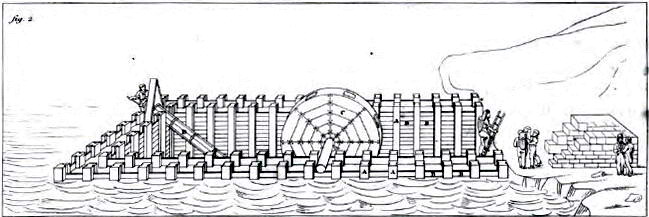
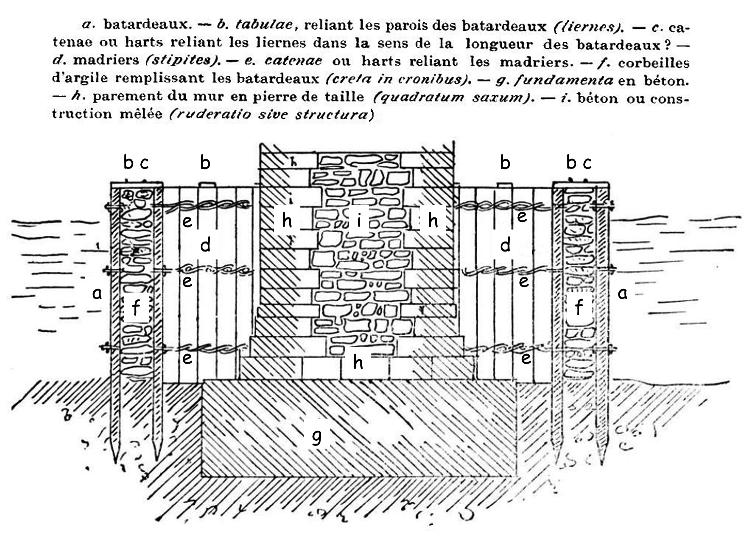
Vitruvius’ second method consists of building the structure from the shoreline and progressing in offshore direction.
If stones are to be dumped into the sea, the stone size must be sufficient to resist wave attack. Stones of tens and hundreds of kilos must be used for the core and covered by an armour layer made of stones of several tons: no technical problem but tricky logistics. This method was used by Alexander when besieging Tyr (in 322 BC, well before Vitruvius).
Floating barges can be used to dump stones further out of the coastline, e.g. to build a man-made island, but barges are exposed to waves and increase risk of down time. This was done at Civitavecchia to build an island at the entrance of the port, as described by Pliny the Younger.
If concrete blocks are to be built into the sea, as Vitruvius seems to suggest, one can think of blocks of several tens of cubic meters built on the beach on top of a small mound made of sand and contained by a small wall (Vitruvius mentions a height of no more than 0.50 m). After hardening of the block, the small wall is removed and sand can be eroded by the sea. The block will then tumble into the sea and the process can be started again. One must be patient … and no application of this method is known. We may perhaps conjecture that Vitruvius deduced this method from what he knew about obelisk raising using a sand box that was gradually emptied through lateral portals (see Rick Brown’s 1999 experiment and illustrative YouTube movie), but that he had no real experience with this method applied to a coastal structure.
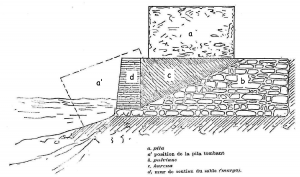
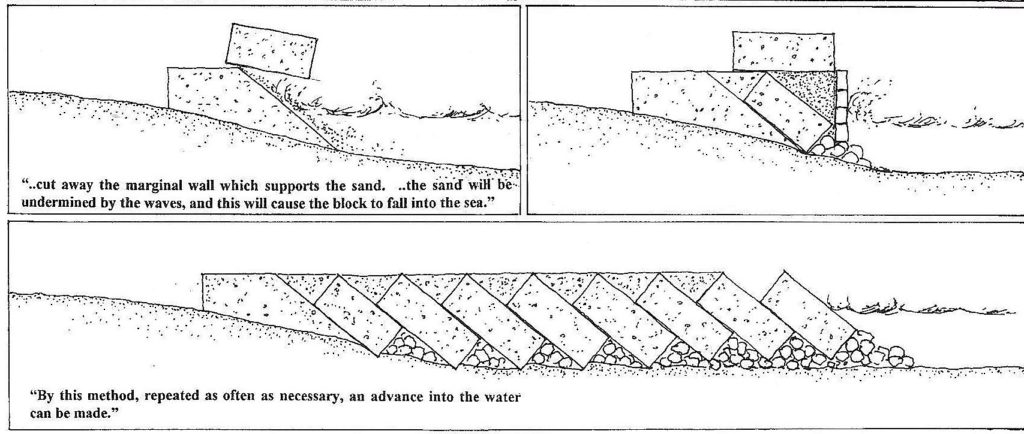
References
[1] OLESON, J., BRANDON, C. & HOHLFELDER, R. & JACKSON, M. & 2014, « Building for Eternity – The history and Technology of Roman Concrete Engineering in the Sea », Oxbow Books, (327 p).
DILARIA, S., et al., 2023, « Volcanic Pozzolan from the Phlegraean Fields in the Structural Mortars of the Roman Temple of Nora (Sardinia) », Heritage 2023, 6, (p 567-587).
[2] OLESON, J., 1985, « Herod and Vitruvius: Preliminary Thoughts on Harbour Engineering at Sebastos; the Harbour of Caesarea Maritima », BAR International Series 257, (p 165-172).
BRANDON, C., 1996, « Cements, Concrete, and Settling Barges at Sebastos: Comparisons with Other Roman Harbor Exemples and the Descriptions of Vitruvius », in « Ceasarea Maritima, A Retrospective after Two Millennia », ed. A. Raban & K. Holum, Brill, Leiden, (p 25-40).
BRANDON, C., 2010, « How did the Romans form concrete underwater? », Historic Mortars Conference, Prague.
and also:
GIANFROTTA, P., 1996, “Harbor structures of the Augustan Age in Italy”, in “Ceasarea Maritima, A Retrospective after Two Millennia”, ed. A. Raban & K. Holum, Brill, Leiden, (p 65-76).
FELICI, E., 1998, “La Ricerca sui porti romani in cementizio: metodi a obiettivi”, Archeologia subacquea, (p 275-340).
FELICI, E., 2000, “Modern development and ancient maritime sites along the Tyrrhenian coast”, Coastal Management Sourcebooks, (p 81-88).
[3] MOERMAN, M., 1994, « Le port romain des Laurons, Martigues », Thèse de doctorat d’archéologie, Université de Provence, 2 vol., (297 p). This 22.9 x 2.2 m caisson is unique, as a stone wall was built in the dry on the wooden floor of the caisson. The remains of the wall are around 1 m high and 1.8 m thick at the base, with a length of 22.5 m. However, the dating of the caisson timbers is still uncertain (possibly 18th c.).
[4] PROCOPIUS, « The buildings of Justinian », 1, 11.
[5] BARTHELEMY, P., 2018, « L’immense port antique de Corinthe sort de l’oubli », Le Monde, 30/5/2018.
[6] DE GRAAUW, A., 1984, “Design criteria for granular filters”. J. Waterw., Port, Coast. and Ocean Eng., ASCE 110 (1984) 1. Delft Hydraulics Laboratory, Publication n° 287.
VOTRUBA, G., 2007, “Imported Building Materials of Sebastos Harbour, Israel”, International Journal of Nautical Archaeology, 2007, 36.2, (p 325-335).
GALILI, E., et al., 2021, “Archaeological and Natural Indicators of Sea-Level and Coastal Changes: The Case Study of the Caesarea Roman Harbor”, Geosciences 2021, 11, 306, (26 p).
[7] GODDIO, F., 2007, “Topography and Excavation of Heracleion-Thonis and East Canopus (1996-2006): Underwater Archaeology in the Canopic Region in Egypt”, Institute of Archaeology, University of Oxford, (136 p), (https://www.franckgoddio.org).
[8] SANCHEZ, C. & JEZEGOU, M-P., 2014, “Les ports antiques de Narbonne”, Parc naturel régional de la Narbonnaise en Méditerranée, (100 p).